Companion planting vegetables, flowers, and herbs gives you a natural way to solve two of the main challenges we face when we grow our own food organically: controlling pests and maximizing our crop yield.
Knowing the best companion planting combinations for herbs, flowers, and vegetables helps you fix both problems without resorting to nasty chemical solutions. Companion planting also helps you build local biodiversity and boosts soil health.
My regular readers know that companion planting is my favorite permaculture technique because it’s so effective and so simple. My vegetable garden is full of a beautiful mixture of herbs, flowers, fruits, and vegetables, all supporting one another and helping me keep my organic produce free from pests and diseases.

It’s not just about mixing plants to deter pests – in fact, many combinations attract beneficial insects as well as birds to eat any invading pests and encourage pollination. Companion planting also helps you get the most from whatever growing space you have available and is equally useful in tiny urban spaces and sprawling rural properties.
I’ve put together a list of my favorite combinations for companion planting herbs and flowers with vegetables to help you get larger amounts of healthy crops from your organic garden, whether you have several acres, a square foot garden, or a vertical garden.
Companion planting brings species diversity not just to the flora, but the fauna, too. When you companion plant, you’re creating a diverse ecosystem – even if you’re creating a tiny one in a square foot bed. And diverse ecological systems are always far healthier and more well-balanced, requiring less human intervention and maintenance because they work as nature intended.
1. Companion Planting Marigolds to Repel Whiteflies & Trap Slugs
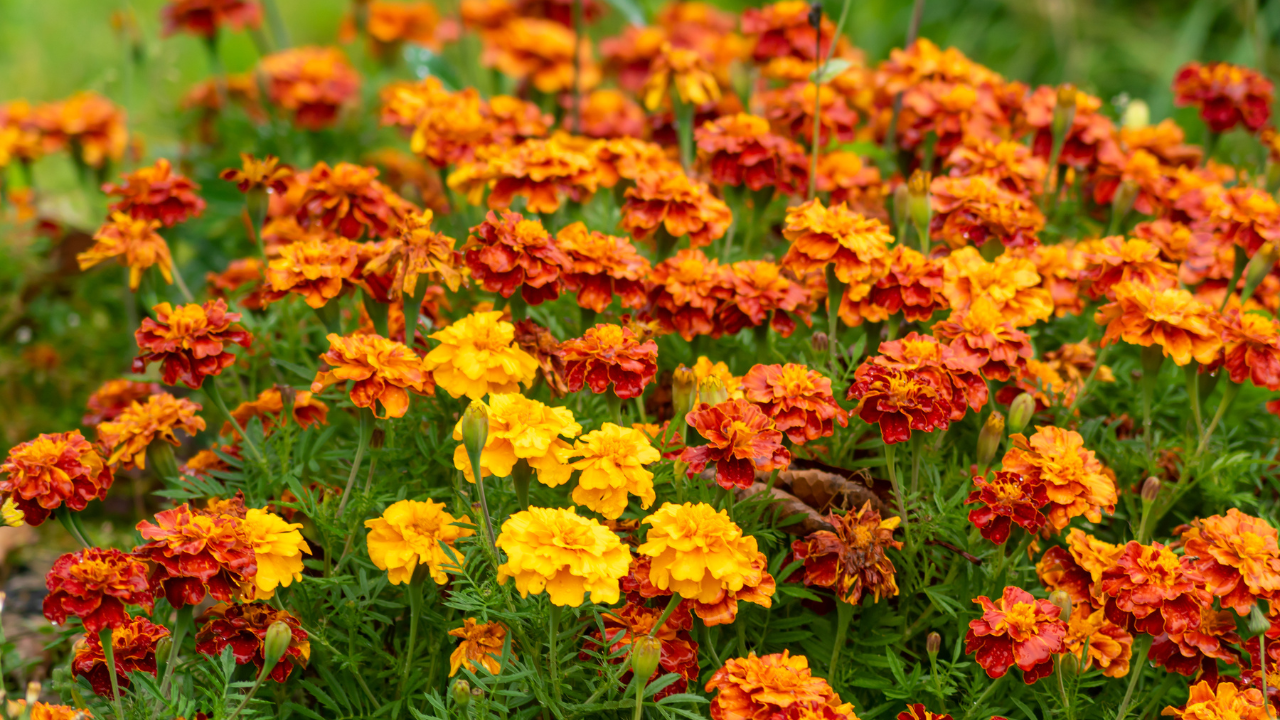
All varieties of marigolds, including pot marigolds (Calendula – we use these for their healing properties), French and Mexican (Tagates) are among the best companion plants for vegetable gardens as well as ornamental gardens.
Plant marigolds to repel whiteflies and ward off nematodes. As companion plants, marigolds are an organic gardener’s best friend, because they help keep slugs off your food crops.
We all know slugs are a total menace, munching their way through masses of young vegetable crops and causing devastation.
But slugs have a weakness: They adore marigolds. Instead of chomping on your veggies, they’ll head to the marigolds and feast there. So plant multiple patches all over the garden – just not too close to beans and brassicas.
And, interestingly, marigold roots exude a chemical that actively repels tiny but potentially devastating soil-borne nematodes.
What Should You Never Plant With Marigolds?
The only vegetables you shouldn’t plant marigolds near are beans and brassicas, according to my family tradition and many other articles.
But I can’t seem to find out why, so more investigation is required. But in the meantime, I think it’s safer not to plant marigolds near my beans and cabbages.
2. Companion Plant Chives With Carrots
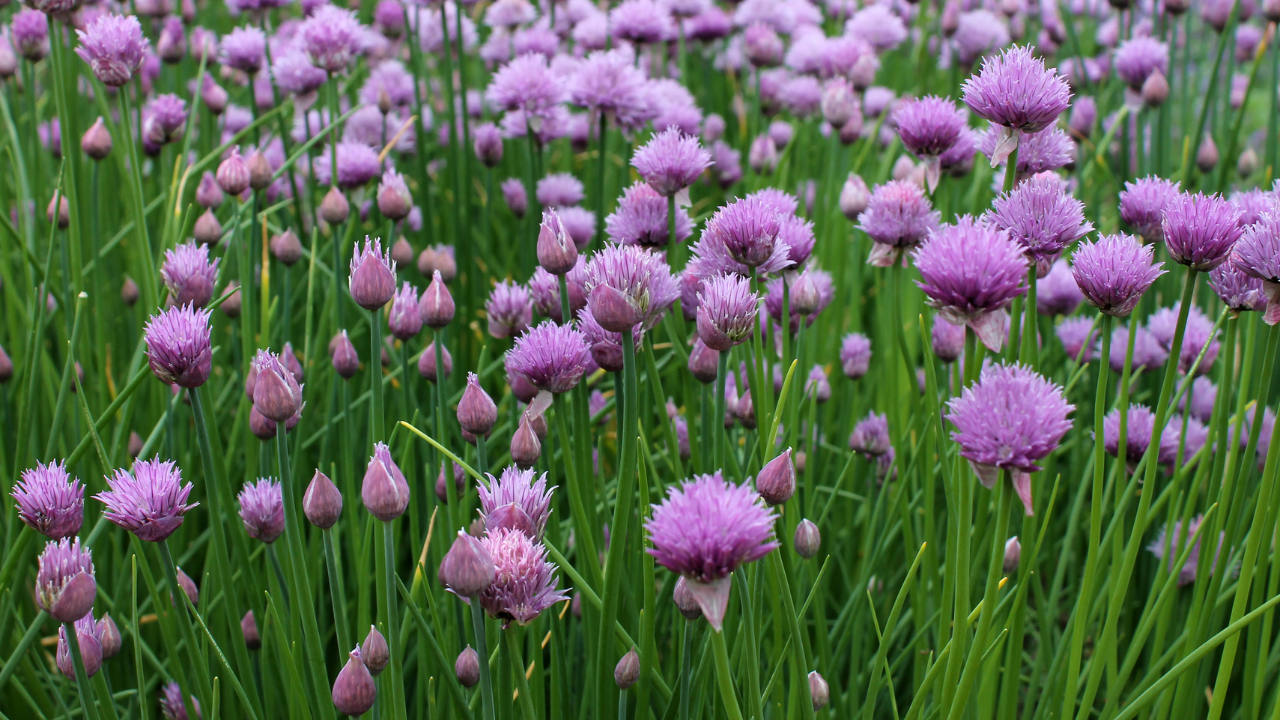
Chives, along with onions, are the ideal carrot companion planting choice. They repel the insanely annoying carrot fly.
As an added bonus, chives also deter whitefly and aphids, they’re easy to grow, and they taste great. They’re also very easy to dry and store for seasoning recipes throughout the year.
What Should You Never Plant With Chives?
You should keep chives away from peas and beans. Chives are members of the allium family, all of which produce and release antibacterial compounds into the soil.
When planted too close to peas and beans, the antibacterial compound from the chives kills the beneficial bacteria that aid in nitrogen-fixing on the roots of the beans and peas. This stunts growth and significantly reduces yield.
3. Companion Planting Sweet Alyssum to Smother Weeds & Attract Bees
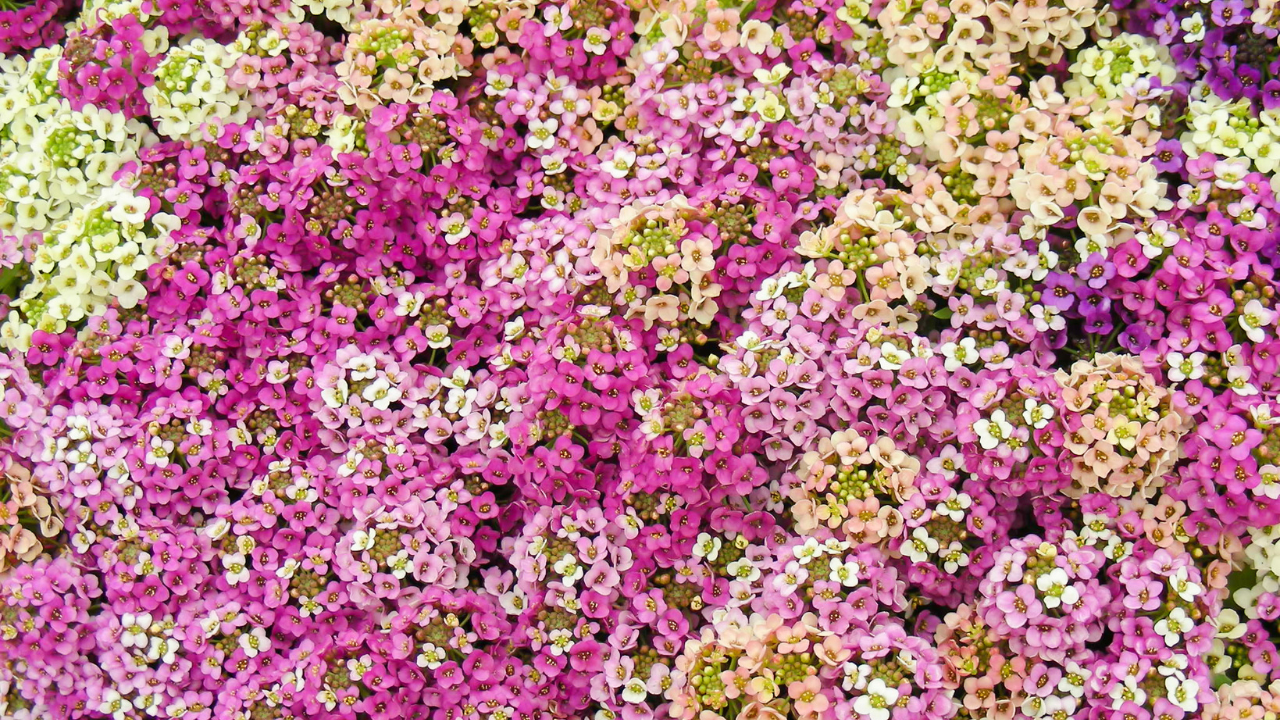
The primary function of companion planting sweet alyssum is natural, organic weed control. It grows quickly, creating thick, low-growing mats that help to prevent weeds, and you can use it as a green manure, too. Plant sweet alyssum on bare earth or in between crop rows, or anywhere else you don’t want to see weeds.
When the growing season finishes, just dig the mats back into the ground to help replenish the nutrients in the soil. When they bloom, the fragrant flowers attract bees to the garden to help with the pollination of your vegetable crops.
What Should You Avoid Companion Planting With Sweet Alyssum
Sweet alyssum is versatile enough that there are no herbs or vegetables that it negatively impacts. Plant it anywhere that you want to suppress weeds and attract bees. And, when you harvest your crops, you can plant sweet alyssum as a green manure or cover crop.
4. Companion Plant Nasturtiums With Squashes & More
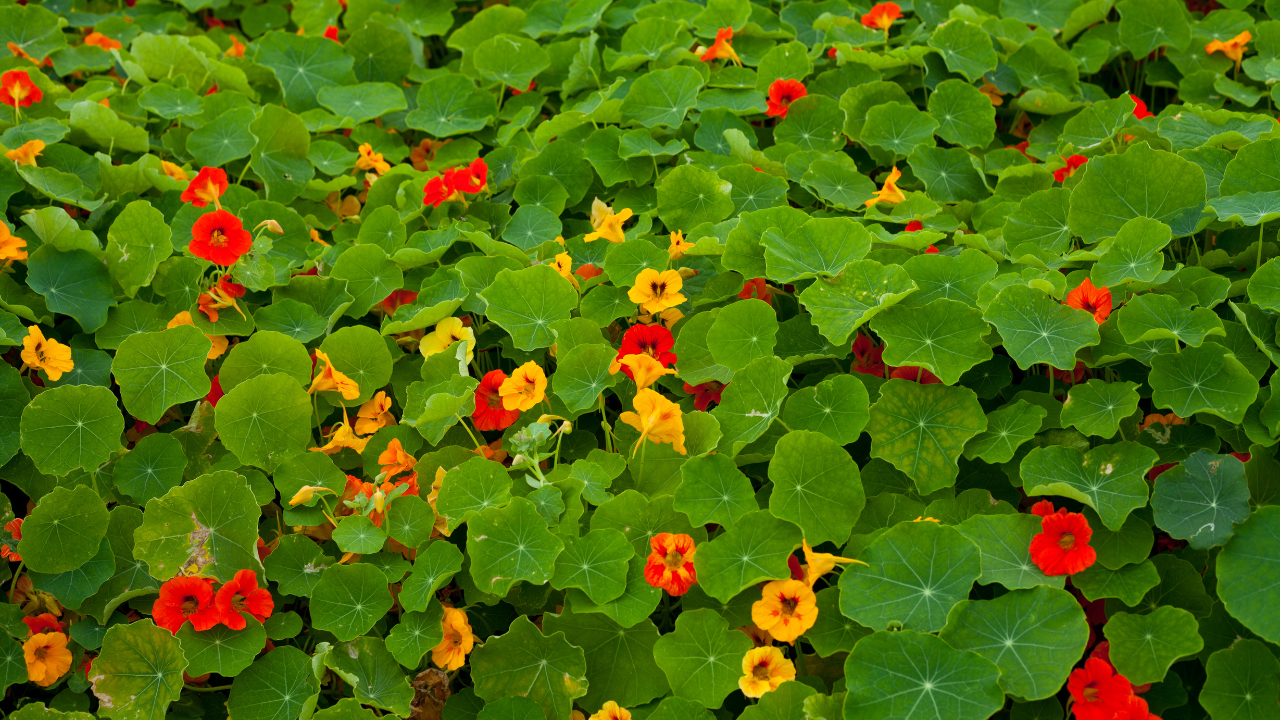
Nasturtium companion planting has multiple benefits. Firstly, they act as decoy companion plants for pests like aphids. This means that nasturtiums attract aphids to themselves and away from neighboring crops. Acting as both decoy and trap, the bright flowers of the nasturtium attract larger predatory insects that feast on tiny insect pests. Nasturtium companion planting also repels a long list of other insects.
Brilliant for planting near members of the squash family, nasturtiums repel squash bugs, pumpkin beetles, and vine borers. Their ability to deter common cabbage family pests like whitefly is another reason for their popularity among organic growers. And, the flowers have a strong, peppery flavor that makes a fabulous addition to salads.
What Should You Avoid Companion Planting With Nasturtiums?
Nasturtiums are fantastic companion plants because they can be planted safely with any other herb or vegetable. They don’t negatively impact the growth or health of any other plant, and they’re such an effective trap crop for insects – particularly aphids – that you don’t have to worry about the aphids wandering away from your nasturtiums to other neighboring plants.
5. Companion Planting Dill With Squashes & Cabbages

For many organic vegetable gardeners, dill is their staple companion plant, particularly in when used in close proximity to members of the cabbage family. Dill firstly improves the growth, health, and flavor of these crops. When in bloom, it also attracts large, predatory wasps as well as ladybugs, lacewings, hoverflies that feast on the pests like aphids and squash beetles that commonly attack squash and cabbage crops.
Dill is a versatile companion plant and, for brassicas, it has another significant benefit: Its scent deters pests like cabbage worm, cabbage moths, and cabbage loopers.
What Should You Not Plant With Dill?
It’s important to note that dill is irresistible to tomato hornworms, so can be used as a trap crop, but shouldn’t be planted too close to tomatoes or peppers. Not only does it attract tomato hornworm, but it also weakens members of the nightshade family and will negatively impact the health, growth, and crop yield of these plants.
You should also avoid planting dill near carrots as they are related, can easily cross-polinate and worse, dill attracts carrot fly, so keep your dill and carrot patches separate!
6. Companion Planting Sage to Deter Pests and Enhance Tomato Flavor
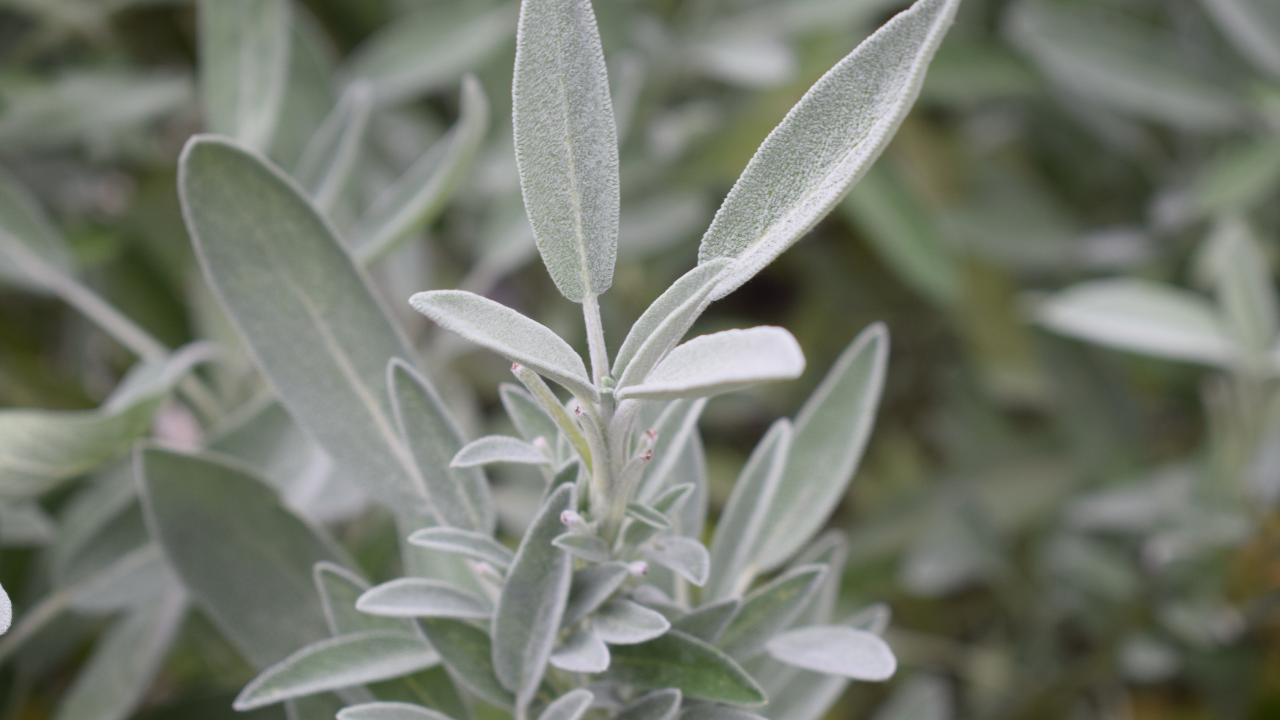
Sage has a strong scent and makes an outstanding companion to the cabbage family, carrots, and tomatoes. This herb wards off the dreaded cabbage moth, along with whitefly and carrot fly. Companion planting sage with tomatoes invigorates the tomato crop, deepens the flavor, and repels troublesome pests like hornworm. Sage is definitely the organic gardener’s friend and should be interplanted throughout the growing area, with only a couple of restrictions.
What Should You Avoid Companion Planting With Sage?
Sage is a potently aromatic herb and therefore should never be planted near cucumbers, as it inhibits their growth and significantly reduces yield. It should also be noted that sage should not be planted with alliums – onions, garlic, leeks, chives – because they require different growing conditions. Alliums do best in moist conditions, unlike sage, which struggles in moist soil and instead requires dry, well-drained conditions.
7. Companion Planting Catnip to Repel Insects and Rodents
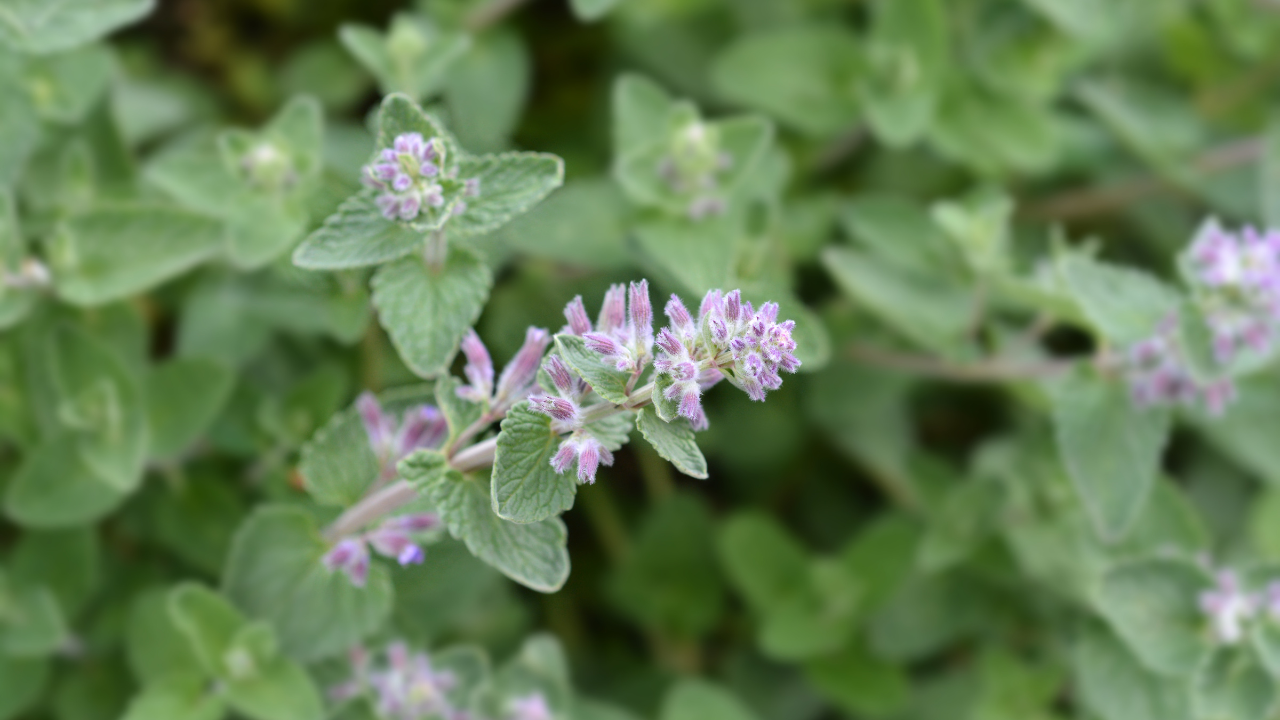
Yep, companion planting catnip is a genuine “thing” practiced by organic growers all over the globe. We all know that catnip is irresistible to cats, and growing catnip gives your cats a healthy, organic supply.
Yes, it does attract cats to your garden, but they’re so entranced by the catnip that they forget all about having a poop or digging up your crops. Plus, having cats around helps to keep rodent populations down.
Planting catnip as a border around crops that are vulnerable to voles, mice, and other rodent pests does wonders, as these little critters loathe the scent of catnip.
One theory claims it’s because the mice associate the scent of catnip with their natural predators. However, I think it’s more likely that the pungent oils in catnip are as abhorrent to mice and rats as they are to the long list of insects catnip repels.
Companion planting catnip deters a long list of insect pests, including ants, flea beetles, Japanese beetles, Colorado potato beetles, cabbage loopers, weevils, aphids, and squash beetles.
Therefore, you should plant it alongside collards, beets, pumpkins, all squash varieties, brassicas, and potatoes.
What Should You Avoid Companion Planting With Catnip?
Catnip is a member of the mint family and can be planted with pretty much anything. However, just like mint, catnip can get out of control fast, so I wouldn’t advise just planting it directly into the soil.
It spreads rapidly and will quickly take over the space. So, if you plan to catnip, make sure you confine it to roomy containers.
Aside from a few sporadic mentions of not planting catnip with parsley (for which I cannot find a valid reason), there is, to my knowledge, no vegetable that cannot be planted with catnip.
8. Companion Planting Yarrow to Attract Predators and Pollinators
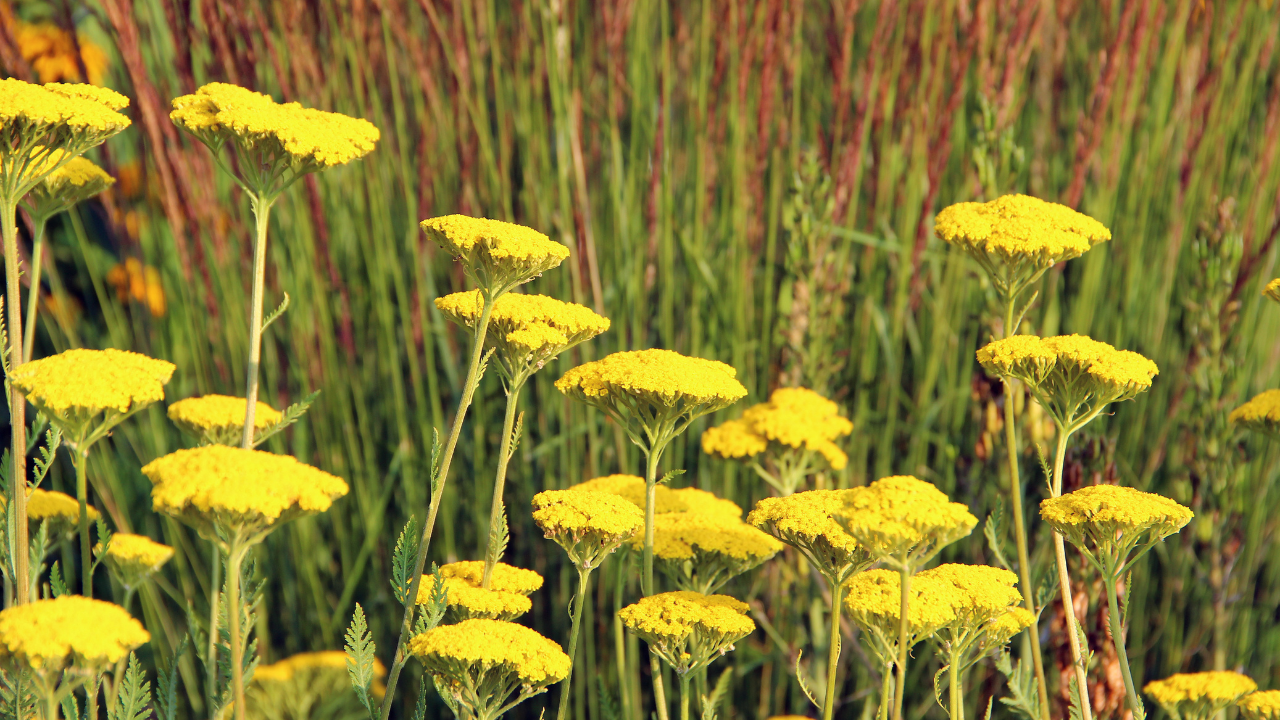
Yarrow has multiple benefits in the vegetable garden. It attracts bees to aid pollination and predatory insects that consume large volumes of pests like aphids. You can get red, white, or yellow varieties. Yellow and white are more common, but I adore the red ones – the colors are just so bold and enticing. So I do plant this variety for its companion planting capabilities, but I also plant the original white yarrow to use in herbal remedies.
It also acts as an organic fertilizer, returning large amounts of nutrients to the soil, and it root systems help to improve the drainage and structure of heavy soils.
So, if you have a patch of compacted earth or some bare, heavy clay that not much will grow in, turn the area, dig in some compost, then use yarrow as green manure, leaving it undisturbed for a few months.
Yarrow has clusters of tiny blooms that draw predatory wasps, hoverflies, lacewings, ladybugs, and other insect-eating insect-eating critters that attack pests like tomato hornworms, aphids, and similar.
It’s not just good for attracting insects – yarrow is directly beneficial to a number of other plants, too. It stimulates the growth of aromatic herbs and helps keep brassicas, squashes and lemons, beans, and spinach healthy and free from pests and diseases.
What Should You Never Plant With Yarrow?
Yarrow happily grows with most other plants and is of benefit to every fruit and vegetable grower, so I’d recommend plating patches of it all over.
However, if you plan to use it medicinally, never plant it near poison hemlock, because they look so similar and, if taken in the wrong dose, it can be fatal.
9. Companion Planting Chrysanthemums to Repel Insects
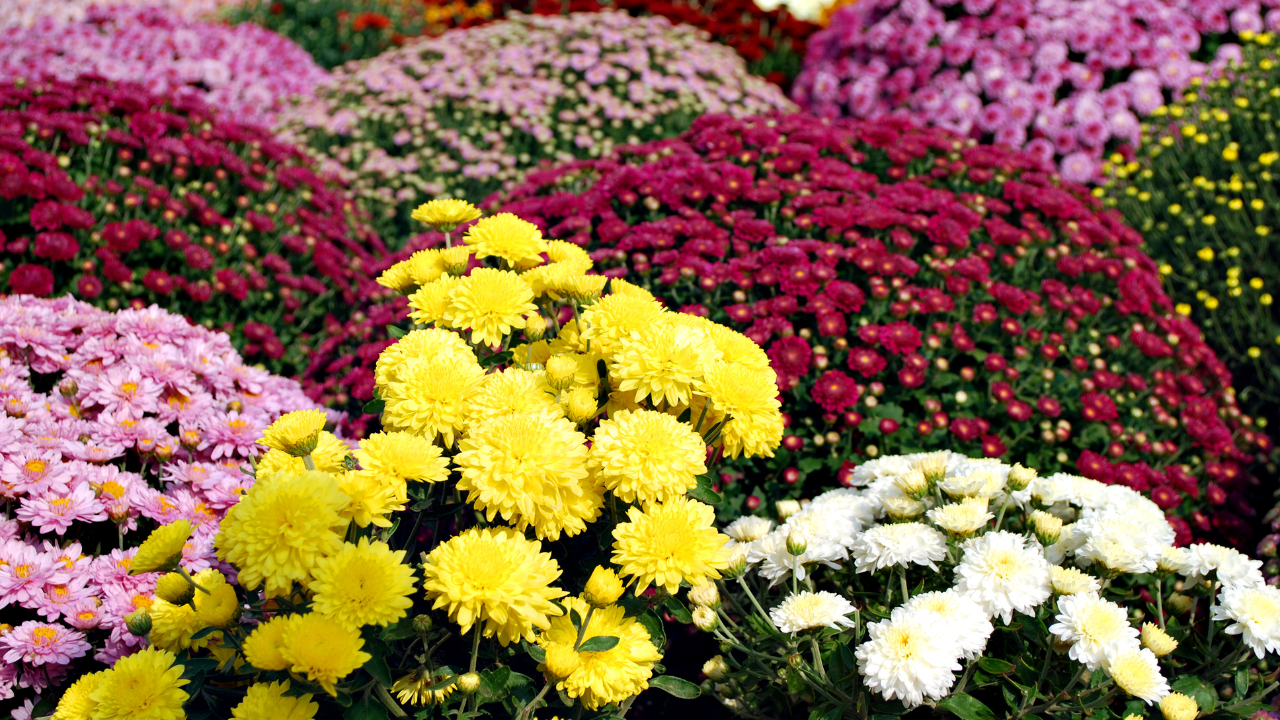
There are a huge number of chrysanthemum varieties, and quite a few of those prove very useful in the vegetable garden. C. coccineum, for example, repels root nematodes, as does C. cinerariaefolium.
Both of these varieties, commonly known as painted ladies or painted daisies, contain high concentrations of pyrethrum.
This natural insecticide contains six distinct pyrethrins which make up a very effective form of natural pest control.
While live chrysanthemums will repel a whole host of bugs, including Japanese beetles, without doing them much harm, the plants don’t discriminate.
Not being sentient, they can’t distinguish between an insect pest and a bee going around pollinating, for example.
Chrysanthemums are also useful as general garden plants because they deter troublesome bugs like silverfish, ticks, lice, and roaches.
NATURAL PEST CONTROL TIP!
Create a general-purpose organic insecticide by drying chrysanthemum flowers, then grinding them with a mortar and pestle. Simply sprinkle the powder all over the garden. You can also steep the powder in some hot water to create a pyrethrum tea. Once it cools, pour the liquid straight onto the insects or the infested area.
Pyrethrum, when it dust or tea form acts as a double-action insecticide, killing a variety of insects on contact and with ingestion. It’s particularly effective against small, soft-bodied beasties like aphids. It’s non-residual, too, so it doesn’t hang around and is non-toxic, so is safe for humans and pets alike.
What Should Not Be Planted With Chrysanthemums?
Any vegetables benefit from being planted with chrysanthemums. Just remember they need moist, free-draining soil and at least 6 hours of full sun to thrive.
So remember to take this into account when figuring out your companion planting choices.
10. Companion Planting Dahlias to Repel Soil Nematodes
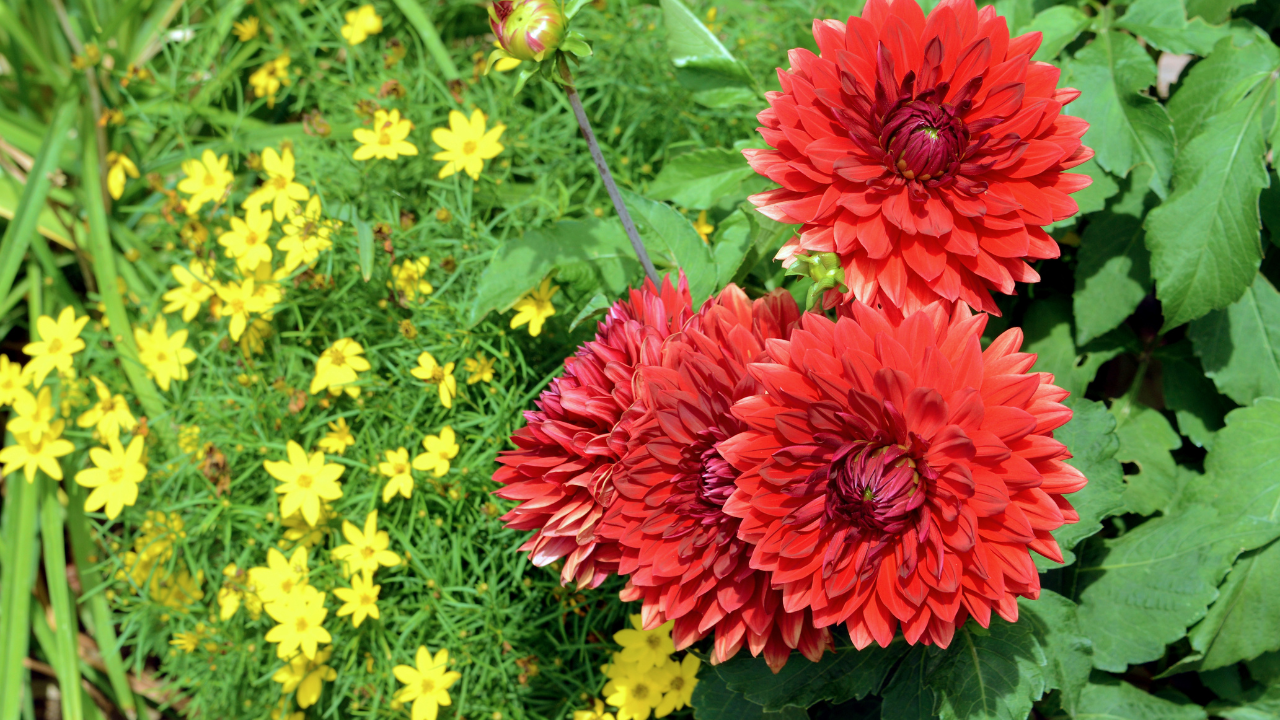
Another awesome nematode-repelling choice, dahlias also have large, bright blooms that attract pollinators. When companion planting dahlias, remember that earwigs cannot resist them.
This isn’t necessarily a bad thing, as most earwig species devour pests like aphids. The drawback is that they’re omnivorous, and are partial to certain vegetable crops, too.
So we advise keeping dahlias away from crops like corn that earwigs love.
What Vegetables Should Never Be Planted Near Dahlias?
While most vegetables benefit from the presence of dahlias, corn, potatoes, sweet potatoes, leafy greens, and peanuts suffer because dahlias attract earwigs, which also eat those vegetables.
However, if you are growing any of those, then you can plant dahlias in a separate area of your growing space to act as a trap crop, attracting the earwigs to the dahlias rather than your edibles.
11. Companion Planting Geraniums for General Pest Control

Geraniums make a beautiful addition to the vegetable garden, and they’re a great choice for attracting pollinators and predators.
Companion planting geraniums with cabbage repels troublesome cabbage worms.
White geraniums are particularly effective against Japanese beetles, earworms, and beet leafhoppers, so are a great choice for planting with corn, grapes, apples, asparagus, beans, and okra.
Scented geraniums, of the Pelargonium genus, are not true geraniums, but are still incredibly useful as companion plants in the vegetable garden.
They repel spider mites and cotton aphids, so are very valuable additions to your vegetable patch, particularly if your area is prone to spider mite infestations.
What Should You Never Plant With Geraniums?
Geraniums don’t negatively impact any vegetable plants, so they are a useful, versatile companion for your edible landscape.
As companion plants, they are pretty good all-rounders and, as an added bonus, they repel mosquitos.
12. Companion Planting Basil for Healthy, Pest-Free Tomatoes and More
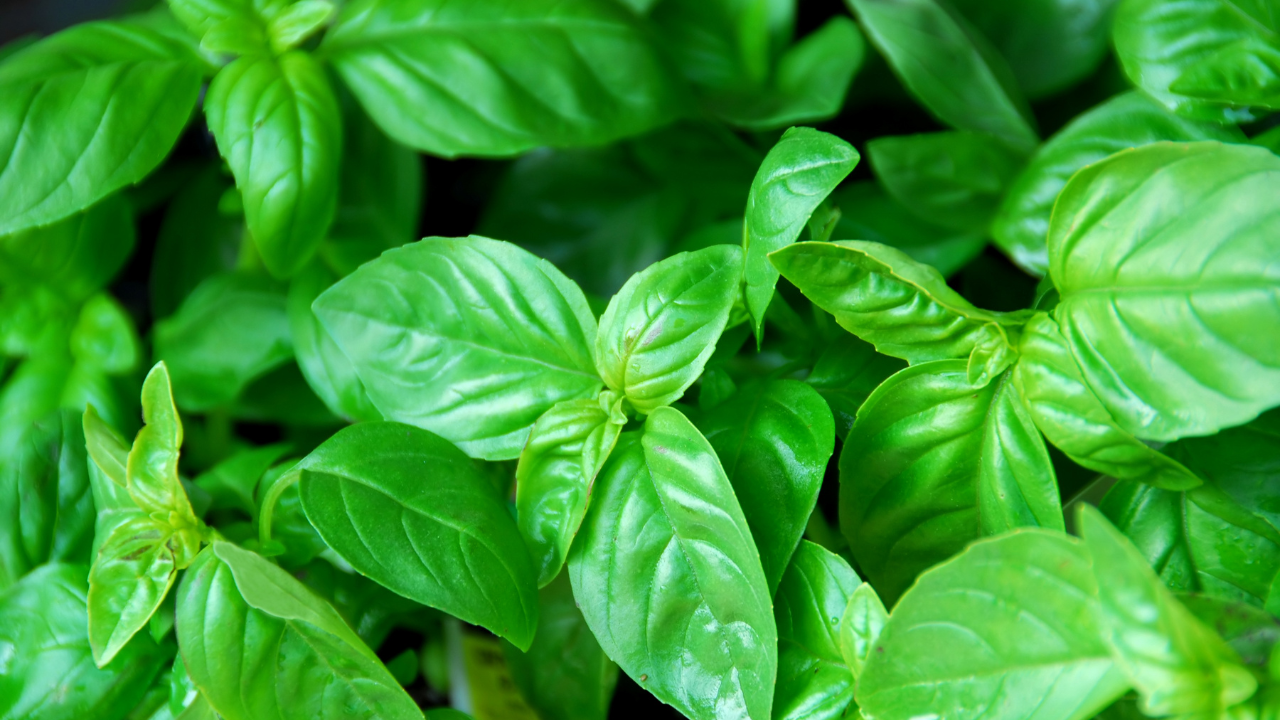
Companion planting basil (we chose these seeds as they’re a robust, easy to grow variety) with tomatoes, peppers, and asparagus, improves their flavor, health, and vigor.
It’s exceptionally useful as a companion plant in the vegetable garden because it repels nematodes, aphids, asparagus beetles, whitefly, black fly, mosquitoes, and tomato hornworm. Beets, potatoes, pole and bush beans also benefit from being planted near basil.
TIP: You can boost the effectiveness of basil by planting chives, chamomile, or oregano near it.
These three herbs boost the intensity of the aromatics in basil, thereby improving its efficacy as a pest deterrent as well as boosting its flavor.
Basil is particularly good for peppers because they like humidity, and basil provides lots of leafy ground cover that traps heat and moisture.
And because it’s so effective against tomato hornworm, basil is the perfect companion plant for tomatoes. Additionally, basil improves the health of tomato plants and increases crop yield.
What Should You Never Plant With Basil?
Because basil attracts butterflies, unless your cabbages and other brassicas are particularly well netted, it’s not a good idea to plant them in close proximity.
Don’t plant basil near cucumbers, as the cucumber’s flavor will be tainted by the flavor of the basil. Additionally, basil, like many aromatic herbs, inhibits the growth of cucumbers and reduces yield.
Aside from chives, chamomile, and oregano, basil should not be planted with other herbs, particularly aromatics.
Rue and sage, for example, produce compounds in their roots that leach into the soil and inhibit the growth of basil.
Now, we know there’s an array of other flowers and herbs that belong in the vegetable garden as companion plants, but these are a few of our favorites.
We also love garlic, but we’re covering that in a separate post, so watch this space! What are some of your favorite companion herbs and flowers?
FAQs
What flowers can I plant with rosemary?
You can plant almost any flowers with rosemary, but if you want to further improve your vegetable garden, I recommend companion plant sweet alyssum, marigolds, and nasturtiums with rosemary.
What are the best flowers to plant with vegetables?
You’ve got a lot of options when it comes to good flowers for companion planting with vegetables. My top choices for versatility and beneficial properties are nasturtiums, marigolds, geraniums, dahlias, chrysanthemums, and sweet alyssum
What vegetables should not be planted together?
Beans and peas should not be planted with onions, garlic, leeks, or chives. Beets and brassicas shouldn’t be planted near pole beans. Don’t plant potatoes near tomatoes, and don’t plant tomatoes near corn or kohlrabi.
Can I plant zinnias in my vegetable garden?
Yes! Zinnias are great additions to vegetable gardens because they attract pollinators, particularly bees. Just be aware that they also attract butterflies, so you probably shouldn’t plant them near your cabbages.
Can I plant sunflowers in my vegetable garden?
Yes! Sunflowers are brilliant for the vegetable garden. They provide frames for beans and other trailing plants to climb, they attract pollinators with their huge, colorful heads and bountiful supply of nectar, and they provide a little bit of shade for plants that don’t like too much sun. Plus, the birds that come to feast on the seeds will also eat many of the insect pests that plague your edibles.

Companion planting has been my go-to in the garden for 15 years now. Every year I learn something new! While I knew that certain plants were sensitive to sunflowers–most dislike them, but oddly bush beans do not object, while pole & lima beans do–this year I want to find out more about flowers. I have a section in the middle of the garden devoted to pollinators, so any flowers not mentioned here as specifically beneficial will either go there or in another bare spot.
Borage is a nice flower that draws pollinators to plants that need it. These days, squashes of all kinds seem to need a little boost with pollination, so I’ll be transplanting several of my little seedling borages here & there–and to the cucumbers, the watermelon, & the cabbage beds. I’ll probably have plenty left for anyone else who needs a friend!
I’ve heard that the orange French marigolds are the most potent at repelling, entrapping, and killing nematodes.
Catnip repels mice; so do all of the mints. These and almost all culinary herbs except fennel, parsley, anise, dill (none of which should be planted together), and tarragon all belong to the mint family botanically. You can tell by their square stems and alternating pairs of opposite leaves. Once you take a look it’s easy to see the “family face”…kind of like roses, apples, and all the stone fruits.
–Catnip and catmint are great to plant around roses, by the way. They repel Japanese beetles and the clouds of lavender-blue flowers over gray-green foliage are lovely with any color rose.
These are great extra tips for companion planting, thank you so much! My readers will definitely benefit from these 🙂
Yes, I agree that the whole squash family needs help with pollination nowadays – that’s what comes of awful pesticides killing off all the pollinators. When necessary, I go and pollinate by hand with a soft paintbrush.
I love reading about companion planting. I finally tried it last year and was impressed. The tomatoes planted in a raised bed with basil did not get worms, the ones planted by themselves did. I enjoyed the experiment!
That’s great! I always think it’s quite amazing how simply considering what you plant together can have such an impact on pests, diseases, and crop yield. And just like you, I love experimenting with new companions! Good luck with your tomatoes this year. 🙂